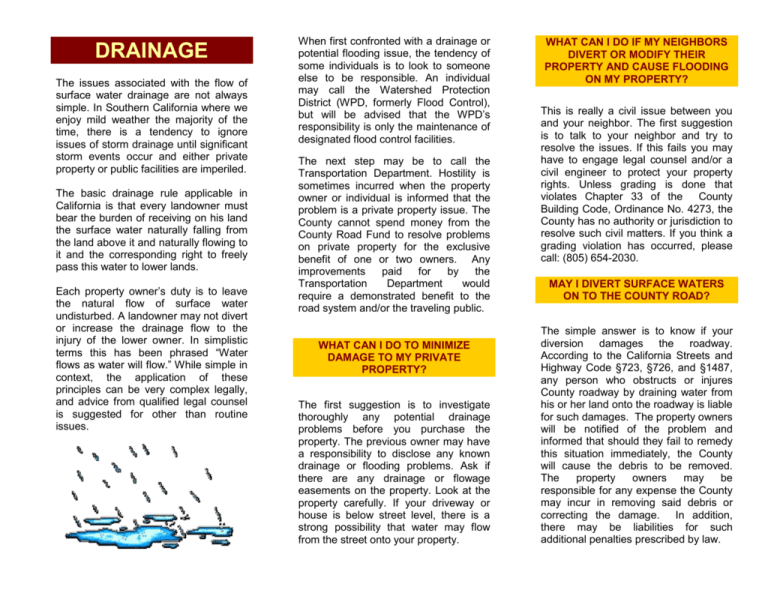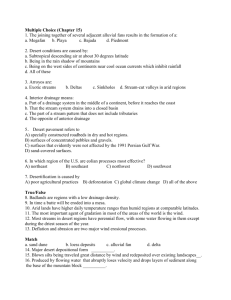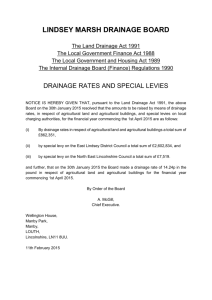ROAD DRAINAGE - Traffex Engineers
advertisement

DRAINAGE The issues associated with the flow of surface water drainage are not always simple. In Southern California where we enjoy mild weather the majority of the time, there is a tendency to ignore issues of storm drainage until significant storm events occur and either private property or public facilities are imperiled. The basic drainage rule applicable in California is that every landowner must bear the burden of receiving on his land the surface water naturally falling from the land above it and naturally flowing to it and the corresponding right to freely pass this water to lower lands. Each property owner’s duty is to leave the natural flow of surface water undisturbed. A landowner may not divert or increase the drainage flow to the injury of the lower owner. In simplistic terms this has been phrased “Water flows as water will flow.” While simple in context, the application of these principles can be very complex legally, and advice from qualified legal counsel is suggested for other than routine issues. When first confronted with a drainage or potential flooding issue, the tendency of some individuals is to look to someone else to be responsible. An individual may call the Watershed Protection District (WPD, formerly Flood Control), but will be advised that the WPD’s responsibility is only the maintenance of designated flood control facilities. The next step may be to call the Transportation Department. Hostility is sometimes incurred when the property owner or individual is informed that the problem is a private property issue. The County cannot spend money from the County Road Fund to resolve problems on private property for the exclusive benefit of one or two owners. Any improvements paid for by the Transportation Department would require a demonstrated benefit to the road system and/or the traveling public. WHAT CAN I DO TO MINIMIZE DAMAGE TO MY PRIVATE PROPERTY? The first suggestion is to investigate thoroughly any potential drainage problems before you purchase the property. The previous owner may have a responsibility to disclose any known drainage or flooding problems. Ask if there are any drainage or flowage easements on the property. Look at the property carefully. If your driveway or house is below street level, there is a strong possibility that water may flow from the street onto your property. WHAT CAN I DO IF MY NEIGHBORS DIVERT OR MODIFY THEIR PROPERTY AND CAUSE FLOODING ON MY PROPERTY? This is really a civil issue between you and your neighbor. The first suggestion is to talk to your neighbor and try to resolve the issues. If this fails you may have to engage legal counsel and/or a civil engineer to protect your property rights. Unless grading is done that violates Chapter 33 of the County Building Code, Ordinance No. 4273, the County has no authority or jurisdiction to resolve such civil matters. If you think a grading violation has occurred, please call: (805) 654-2030. MAY I DIVERT SURFACE WATERS ON TO THE COUNTY ROAD? The simple answer is to know if your diversion damages the roadway. According to the California Streets and Highway Code §723, §726, and §1487, any person who obstructs or injures County roadway by draining water from his or her land onto the roadway is liable for such damages. The property owners will be notified of the problem and informed that should they fail to remedy this situation immediately, the County will cause the debris to be removed. The property owners may be responsible for any expense the County may incur in removing said debris or correcting the damage. In addition, there may be liabilities for such additional penalties prescribed by law. WHAT CAN BE DONE ABOUT MY DRIVEWAY BECOMING FLOODED EVERY TIME IT RAINS? This situation occurs because many driveways slope down from the edge of the road to the house or business. This may also occur if the culvert or drainpipe under your driveway is too small for the existing flow. To address the problem, it may be necessary to install a pipe to carry the water under the driveway or deflect the water away from your driveway. The maintenance of your driveway, including any drainage pipe or culvert under the driveway is your responsibility as the private property owner. For work in the road right-of-way, an encroachment permit from the Transportation Department will be required, and we recommend you have the work done by a licensed private contractor. WHO IS RESPONSIBLE FOR PROVIDING PROPER DRAINAGE FOR NEW DEVELOPMENT PROJECTS? Whenever a new development project increases the storm water discharge above the existing flow rates for the property, developers are required to control the drainage on their properties to current flow rates. Otherwise, documentation must be provided demonstrating that drainage from their property can be adequately handled during 10, 50, and 100-year storms without adversely impacting adjacent properties or County roadways. WHAT DOES THE COUNTY DO TO ADDRESS DRAINAGE PROBLEMS BEFORE THE RAINS BEGIN? Each year, the Transportation Department’s maintenance staff performs routine maintenance to make sure that when it rains, water drains properly from the roadway systems so that flooding does not impact the travel lanes. However, in heavy rainstorms, the existing drainage systems may become overtaxed. If you see a blocked culvert or drainage inlet, please contact the road maintenance staff at (805) 672-2131 to report the problem. It should be noted that there are many areas of the County where there are no existing drainage facilities. Several of these areas are low, and in some cases below the historical flood plain. Ponding or even flooding may be unavoidable in such areas during heavy storm events. REQUESTS AND INQUIRIES If you have questions, requests, or suggestions, please call Department at: or through the “Contact Us” link at: Rev. 2/21/08 DRAINAGE






